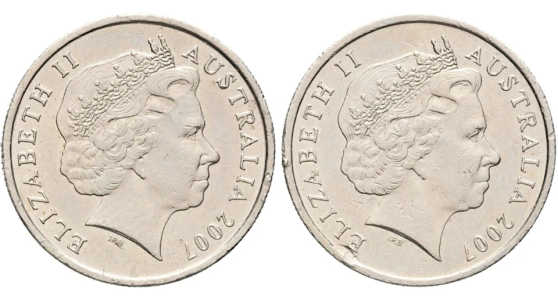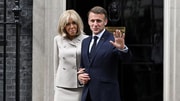That old five cent coin in your junk drawer? It might be worth $1,250
By
Maan
- Replies 3
A tiny Aussie coin just sold for a jaw-dropping sum—but it wasn’t made of gold or covered in diamonds.
Its value lay in a surprising minting blunder you’d never expect to find in your loose change.
And collectors were more than happy to pay a pretty penny for the mistake.
In a rare turn of events, a 2007 five cent coin featuring Queen Elizabeth II’s head on both sides sold for $1,250 at Roxbury’s Auction House.
This so-called ‘double header’ coin wasn’t designed as a novelty—it was the result of an error at the Royal Australian Mint that saw a small number of flawed coins mistakenly released into circulation.
Roxbury’s director Scott Waterman shared that the unusual coin’s popularity with collectors helped push its price well beyond its face value.
‘The fact that it is double heads is really what makes it desirable and valuable,’ he said.
The Royal Australian Mint produced 59 million five cent coins in 2007, but only an estimated 1,500 to 3,000 are believed to have the double obverse error.
Waterman explained that while single error coins occasionally appear—with either double heads or double tails—it’s rare for so many to be released.
‘You get single coins, occasionally double heads or double tails. But very rarely do you get that many that are released into circulation,’ he said.
The coin was sold alongside 2,500 other rare items, including a piece of Australian currency history known as the Holey Dollar—the first coin struck in Australia—which is expected to fetch between $90,000 and $100,000.
Another standout in the auction is the Rainbow Pound, created during note shortages in World War I.
Only 32 are known to still exist, and it’s tipped to sell for between $16,000 and $20,000.
According to Waterman, many of the country’s most prized coins were born from accidents, not deliberate designs.
‘The 1930 Penny, for instance, was an accident. So it’s quite often not by design and they’re not even aware of it until sometimes 20 years later. In the case of the 1930 Penny, no one knew they existed until the 50s, so that’s kind of what makes the legend of it,’ he said.
Dubbed ‘the King of Australian Coins’, the 1930 Penny is thought to exist in similar quantities to the double header—with around 1,500 in circulation—despite the Melbourne Mint not receiving orders for new coins that year.
Waterman added that since decimal currency was introduced in 1966, minting errors like these had remained an exceptionally rare occurrence in Australia.
If you found the double-headed five cent coin story surprising, you're not alone—plenty of everyday coins have turned out to be hidden treasures.
In fact, one man recently discovered a similar coin in an old money box and ended up thousands of dollars richer.
His experience shows just how easily these rare finds can slip through unnoticed—until they don’t.
Read more: Pocket change into fortune? Man turns 5c coin into $2,000

Ever checked both sides of your spare change—just in case you’re holding a hidden fortune?
Its value lay in a surprising minting blunder you’d never expect to find in your loose change.
And collectors were more than happy to pay a pretty penny for the mistake.
In a rare turn of events, a 2007 five cent coin featuring Queen Elizabeth II’s head on both sides sold for $1,250 at Roxbury’s Auction House.
This so-called ‘double header’ coin wasn’t designed as a novelty—it was the result of an error at the Royal Australian Mint that saw a small number of flawed coins mistakenly released into circulation.
Roxbury’s director Scott Waterman shared that the unusual coin’s popularity with collectors helped push its price well beyond its face value.
‘The fact that it is double heads is really what makes it desirable and valuable,’ he said.
The Royal Australian Mint produced 59 million five cent coins in 2007, but only an estimated 1,500 to 3,000 are believed to have the double obverse error.
Waterman explained that while single error coins occasionally appear—with either double heads or double tails—it’s rare for so many to be released.
‘You get single coins, occasionally double heads or double tails. But very rarely do you get that many that are released into circulation,’ he said.
The coin was sold alongside 2,500 other rare items, including a piece of Australian currency history known as the Holey Dollar—the first coin struck in Australia—which is expected to fetch between $90,000 and $100,000.
Another standout in the auction is the Rainbow Pound, created during note shortages in World War I.
Only 32 are known to still exist, and it’s tipped to sell for between $16,000 and $20,000.
According to Waterman, many of the country’s most prized coins were born from accidents, not deliberate designs.
‘The 1930 Penny, for instance, was an accident. So it’s quite often not by design and they’re not even aware of it until sometimes 20 years later. In the case of the 1930 Penny, no one knew they existed until the 50s, so that’s kind of what makes the legend of it,’ he said.
Dubbed ‘the King of Australian Coins’, the 1930 Penny is thought to exist in similar quantities to the double header—with around 1,500 in circulation—despite the Melbourne Mint not receiving orders for new coins that year.
Waterman added that since decimal currency was introduced in 1966, minting errors like these had remained an exceptionally rare occurrence in Australia.
If you found the double-headed five cent coin story surprising, you're not alone—plenty of everyday coins have turned out to be hidden treasures.
In fact, one man recently discovered a similar coin in an old money box and ended up thousands of dollars richer.
His experience shows just how easily these rare finds can slip through unnoticed—until they don’t.
Read more: Pocket change into fortune? Man turns 5c coin into $2,000
Key Takeaways
- A 2007 five cent coin with double heads sold for $1,250 at auction.
- The minting error occurred at the Royal Australian Mint and slipped into circulation unnoticed.
- Experts estimate only 1,500 to 3,000 double-headed coins exist.
- Other valuable items in the auction include the Holey Dollar and Rainbow Pound.
Ever checked both sides of your spare change—just in case you’re holding a hidden fortune?








